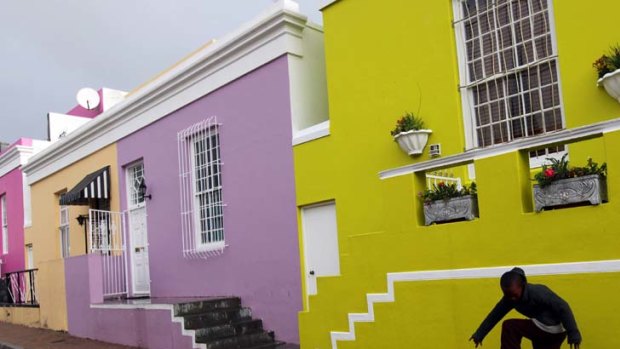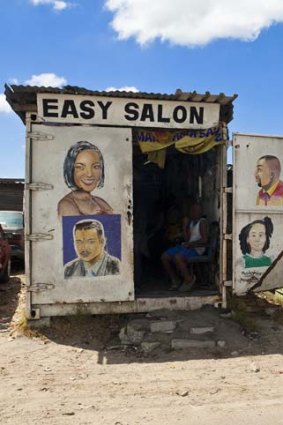This was published 12 years ago
Beyond black and white
Apartheid's scars run deep in Cape Town; community spirit runs deeper still. Kerry van der Jagt takes a tour that encompasses both.

United colours ... houses in Bo-Kaap, Cape Town.Credit: Getty Images
IT TAKES wisdom, understanding and a degree in history to make sense of the reality of apartheid South Africa. Sadly, I've come to Cape Town with none of these in my kitbag.
Driving to Khayelitsha, South Africa's largest single shanty town and home to 1.2 million people, I feel as flat as a sheet of cardboard.
"Welcome to Kuwait," a giant billboard mocks. Amid the dust and rubble an endless grid of corrugated tin shacks, portable toilets and electrical wires stretch as far as the eye can see. It's a wounded landscape of poverty, unfair beyond all comprehension.

A hairdresser in Langa township.Credit: Getty Images
I'm on a full-day Walk to Freedom tour with Roots Africa Tours, a company committed to providing opportunities and tangible benefits to the communities it visits.
"Today you'll see poor children and dirty children but never undernourished children," says my guide, Owen Jinka.
"These people are at peace, they're just seeking opportunity."
Our tour starts at Bo-Kaap, Cape Town's traditional Malay quarter built on the slopes of Signal Hill above the city centre.
The flat-roofed, two-storey houses, painted in edible colours of pistachio, mint and saffron, are still mainly occupied by Malays, the descendants of slaves who were brought over to the Cape from the East Indies.
"The original Khoisan people had lived in these parts for thousands of years," Jinka says as we make our way towards the markets, "but in 1652 the Dutch East India Company settled here and began importing slaves from Malaysia and Madagascar."
At spice stalls, cardamom, cayenne and curry form mounds in gleaming copper pots and chillies dangle from doorways like festive garlands. Nearby, men in overalls apply fresh paint, sherbet colours spilling from their tins.
From Bo-Kaap we drive through the city centre where Jinka points out apartheid monuments, including the Slave Lodge, which housed the slaves of the Dutch East India Company; City Hall, where Nelson Mandela made his freedom speech when he was released from prison; and the De Tuynhuys building where, in 1992, former South African president F. W. de Klerk announced the end of apartheid to the world.
"We tell our children so we will never forget the darkest days," Jinka says. "Particularly what happened at District Six."
Between 1968 and 1983, about 60,000 people were forcibly removed from their homes in District Six and made to live in what are known as "townships". What was once a vibrant community is now a weed-ridden wasteland, a brick path and rubble the only remains of homes demolished when the apartheid government of the time enacted its "whites only" policy and removed black and mixed-race people from the city. "They'd stick a pencil in your hair and if it stayed in place, you were safe," Jinka says. "If it fell out, you had to go."
Cape Town's largest township, Khayelitsha, is a 30-minute drive from the city centre. Our first stop is the Philani Development Centre, a community-based organisation that helps mothers and their babies through outreach, providing health and nutrition rehabilitation, a dental clinic, HIV education, a preschool and a self-employment craft centre.
This is no drive-by "poverty tour". We are invited to watch the women at work, the poorest of the poor learning skills that will help them to become self-sufficient, including weaving, beading, screenprinting and jewellery making.
From Philani we move to another community-based enterprise – Vicky's B&B.
Vicky welcomes guests to stay overnight with her family in her relatively spacious, shack-style house. Since opening her doors to guests in 1998, another 17 B&Bs have started in Khayelitsha, as well as businesses such as the strangely named Waterfront Cash and Cool Spot. "For every seven tourists who come into Khayelitsha, one full-time job is created for a local," Vicky says."When you stay here you are a guest of the entire community, not just a guest of Vicky."
We drive to the adjoining township of Langa for lunch at Lelapa, meaning "home" in Sotho, where local matriarch Sheila Mahloane has opened her house as a restaurant.
"I noticed tourists were coming into the town but no one was stopping," she says. "We now have nine girls working in the kitchen."
This is no mean feat in a township with 70 per cent unemployment.
We press on for the second part of the day's tour, to Robben Island, where Nelson Mandela was held from 1964 to 1982 – that is, for 18 of his 27 years of imprisonment. Today, as a museum and World Heritage site, it serves as a stark reminder of the price paid for African freedom.
A 30-minute ferry ride brings us to the island where a bus takes us on the 12-kilometre trip around the facility. The lowlights are many: leper graveyard, lime quarry – where Mandela spent 13 years doing hard labour – and the house where Robert Sobukwe, one of the founders of the Pan African Congress, was kept for four years in solitary confinement.
Then we come to the prison itself where we meet Sipho Mkosi, a former political prisoner and today our guide. During a tour of the notorious maximum security prison and Mandela's cell, Sipho recounts the bad days. "Black prisoners were not given any underwear, shoes or socks," he says. "But they were allowed cigarettes – to kill themselves, I guess."
The thing that surprises me most is the lack of bitterness. "Please be an ambassador for the new South Africa," Sipho asks. "We have forgiven the past so we can rebuild our future for our children."
My kitbag started out devoid of wisdom and understanding but this tour has filled it with optimism.
Trip notes
Getting there
Qantas flies daily from Sydney to Johannesburg. Fares start at $1600 return. 13 13 13, qantas.com.au. British Airways flies from Johannesburg to Cape Town.
Staying there
Taj Cape Town has rooms from 1950 rand ($270) a night and is within walking distance of many historic apartheid sites. +27 21 423 3000, tajhotels.com.
Vicky's B&B costs 250 rand for dinner, bed and breakfast. C-685A Kiyane Street, Khayelitsha, Cape Town. +27 82 225 2986.
Touring there
Roots Africa Tours runs day tours and half-day tours, priced from 400 rand a person. +27 21 913 9553, rootsafrica.co.za.
More information
Philani Development Centre philani.org.za, southafrica.net.
The writer was a guest of Taj Cape Town and Qantas.
Sign up for the Traveller Deals newsletter
Get exclusive travel deals delivered straight to your inbox. Sign up now.